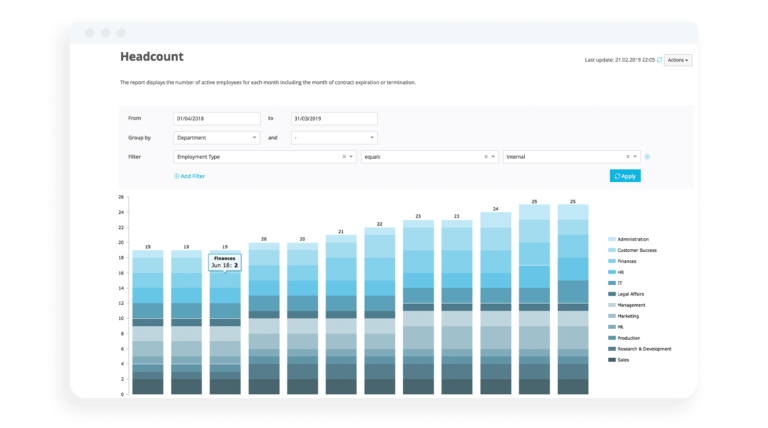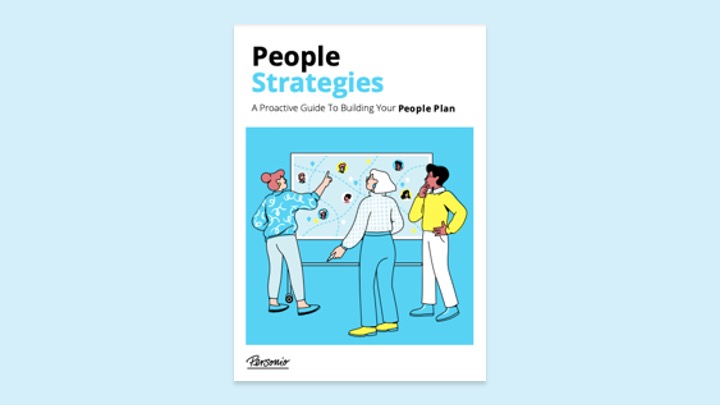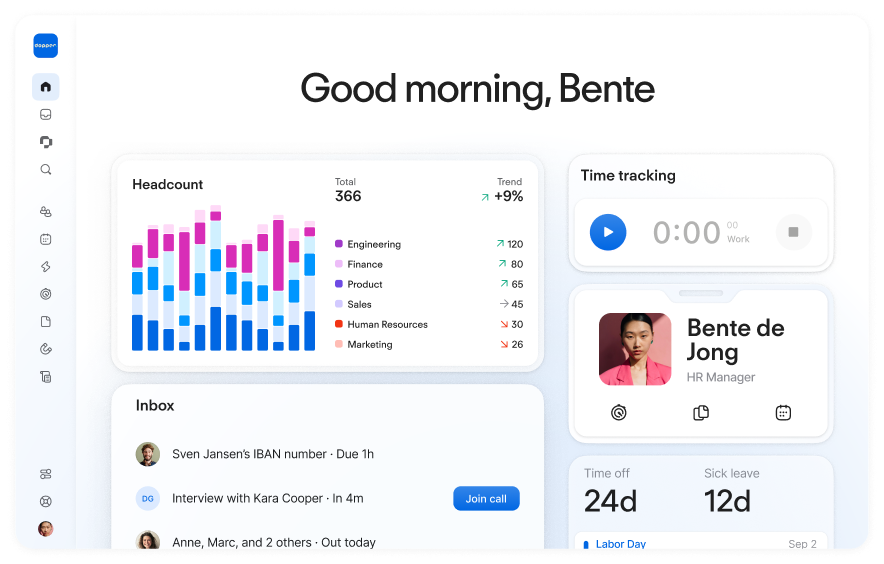10. August 2021
The 5 Metrics That Help Track Employee Wellbeing

At Personio, employee wellbeing was important to us well before the pandemic. With measures like yoga sessions and flexible working options, we emphasized supporting the health, satisfaction, and work-life balance of all our teams.
And yet, Covid-19 still found a way to shake things up! It had us re-evaluate, adapt, and expand our previous measures. So, how did we come to these decisions? Was it based on gut feeling? Nope. Instead, we used data to make decisions to determine our initiatives.
In this article, I want to share some insights into why employee wellbeing belongs on every HR team's agenda, and how we measure the wellbeing of our employees here at Personio. – Cassandra Hoermann, People Experience Lead at Personio
Download our guide to developing your organization’s own people strategy today.What ‘Employee Wellbeing’ Means At Personio
Healthy teams equal healthy business. That said, the word "healthy" can be interpreted in many ways: It can be about satisfaction, mental and physical strength, balance, but also about the (emotional) connection that exists between employees and companies.
In our own work, we have defined how our employees should feel, and this serves as our North Star or compass for all of our wellbeing-related measures. But, what does that look like?
We have defined that our employees should:
Feel that their work is valuable and meaningful.
Be healthy, happy, and satisfied, but also have fun!
Identify with our company core values and act in a value-based manner.
Enjoy a strong work-life balance.
Trust us as an employer that will support them in the best ways possible.
Investing in the wellbeing of your employees is one of the best things you can do for your organization. That’s because employee burnout can lead to disaster for your business.
Employee wellbeing has even become quite the hot topic! For example, REBA’s Employee Wellbeing Research 2020 Reportshows that twice as many companies (52%) are looking to develop an employee wellbeing strategy in 2020 than compared to 2019 (25%).
5 Metrics To Measure Employee Wellbeing
Measuring employee wellbeing gives you the data you need to regularly scrutinize measures, identify (potentially negative) trends, and react quickly.
You can start by using these five metrics as a guide:
Employee Feedback/Ratings: You should regularly solicit opinions from your employees, because asking is one of the best ways to see how someone is feeling.
Productivity Levels: Place your happiness rating against company success. Do your employees feel good, and is your business able to achieve all its goals?
Sick Days: This metric can signal too many overworked employees, or generalized stress from work or overall dissatisfaction.
Overtime: If teams are spending too much time working, it can mean too much workload, misalignment in priorities, too-tight deadlines, or poor time management.
Fluctuation Rate: If, all of a sudden, your fluctuation rate sharply rises, this can be a sign of general dissatisfaction within the company.
Keep In Mind: For Engagement and Attendance Rates
While many companies will use engagement and attendance rates as key determining metrics, I’d proceed with caution. Here’s why…
When it comes to engagement, you should keep in mind that your employees have different personalities. Basically, you’ll have introverts and extroverts.
While extroverts may enjoy participating in events, introverts likely prefer keeping to themselves. Although their engagement may appear lower, they could still be quite happy with their work.
In addition to that, attendance or working days simply doesn’t say enough about what employees are doing or how satisfied they are with their work. After all, employees could also come to work even when dealing with physical or mental illnesses.
Generate Custom Reports In A Flash

Empower your team with HR software that can generate standard and custom reports in only a few clicks. Personio’s library of analytics is here to help — click the button below to see it in action.
Create Your First Report4 Measures To Help ‘Measure’ Wellbeing
While we may have a better idea of the KPIs we’d like to track, how do we accumulate the data to get us there? Here’s what I’d recommend…
Send Out Surveys
Define questions you want to ask your employees on a regular basis. Then compare the results on a month-by-month basis.
Examples:
On a scale of 1-10, how stressed do you feel?
How do you currently rate your workload?
How do you relax, e.g. through sports, meditation, walks?
What worries you most at work right now?
Collaboration With Project Groups
At Personio, we have an Employee Advisory Board that consists of several employees coming from different departments and locations.
They help represent the entire team and give us a better understanding of how employees feel and what they may want. This kind of qualitative data can be truly invaluable.
Overall Employee Performance
Take a look at employee performance. Has it deteriorated in recent months? If so, it might be worth having a private conversation where you can go into more detail about an employee’s current situation and what might be negatively affecting their work.
Technology
There are two aspects coming into play here: The first is that software helps you collect and analyse data from any of the above metrics. Second, though, is that tools can facilitate communication between colleagues — even remotely — and can pay dividends for wellbeing.
Download Our People Strategy Guide

Putting employee wellbeing in focus requires a strategy built around your people. Download our guide and roadmap to developing your own people strategy, direct from Personio’s Chief People Officer, today.
Download The GuideOur 5 Best Practices for Employee Wellbeing
Within Personio’s People Experience Team, analyses and measurements like this have helped us craft measures and adapt them to the unique needs of our employees.
What follows are just some of the things we’ve done, based on the data we collected (and the measures that got us there) to help improve employee wellbeing:
We organise virtual health weeks wherein we offer courses covering stress management, better sleep quality, or yoga, for instance.
Mental health is extremely important. So, we introduced benefits around this topic, e.g. TherapyChat® and Selfapy® – a kind of online coaching and therapy for depression, anxiety, and panic attacks.
#WeAreInThisTogether: We seek to create a sense of community with motivational postcards and stories shared in our weekly company meeting (and on our blog).
We send out monthly Pulse Surveys regarding how people feel about working from home to better understand the differing setups and optimize our responses.
Remote work is also new for managers. With how-to sessions, we support them in leading their teams optimally through this challenging time.
Corporate Culture Plays A Major Role
Your culture will determine, for example, how your employees see your wellbeing initiatives, and how well they engage with them, too.
After all, your employees should have the confidence to talk to their manages about any problems they may be having. But, this only works in a culture based on openness and trust.
Sadly, no tool in the world will improve the wellbeing of employees if they don’t open up for fear of being seen as week or not resilient, so you need to address that root cause first.
Finally, every person and every employee is different. For your wellbeing measures, this means responding individually to employees’ wishes so that they feel heard, supported, and comfortable, at all times.

Cassandra Hoermann
Cassandra Hoermann has been leading Personio’s Employer Branding & Culture efforts since 2018. In that time, Personio has gone from 100 to nearly 1,000 employees and her efforts have helped attract top talent to the team. A sports enthusiast, foodie, and a people person through and through, Cassandra is an expert at connecting with people and bringing them together, too.


